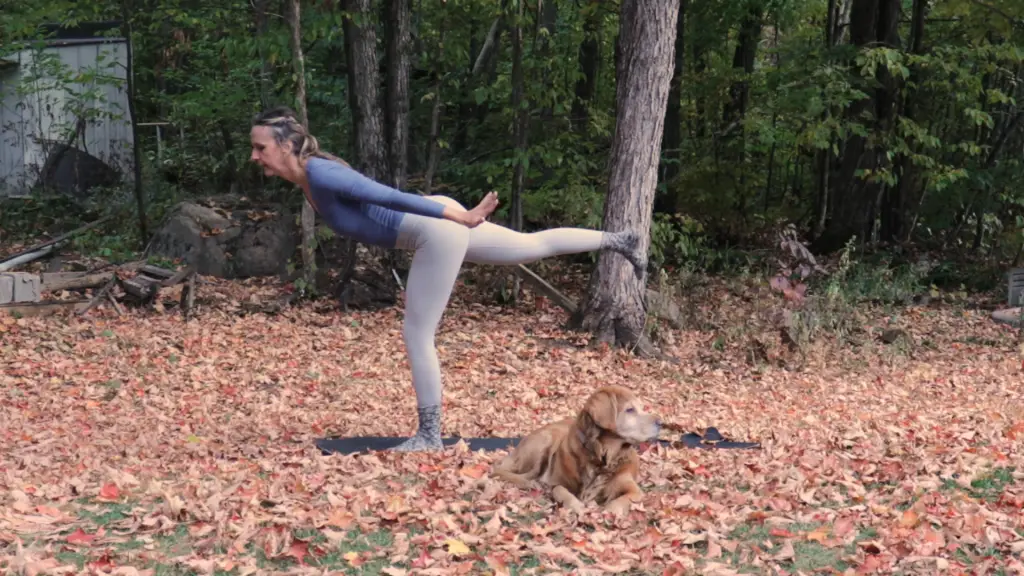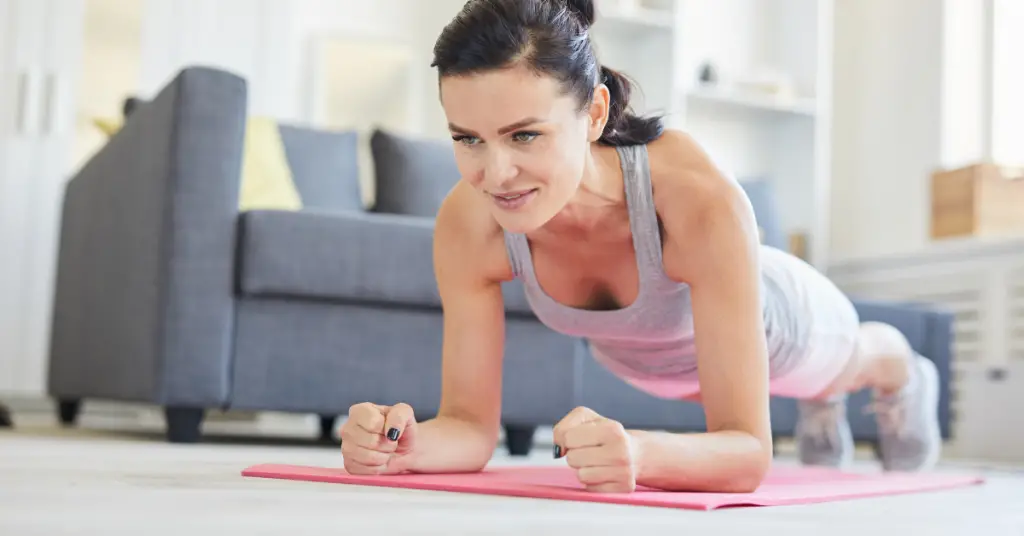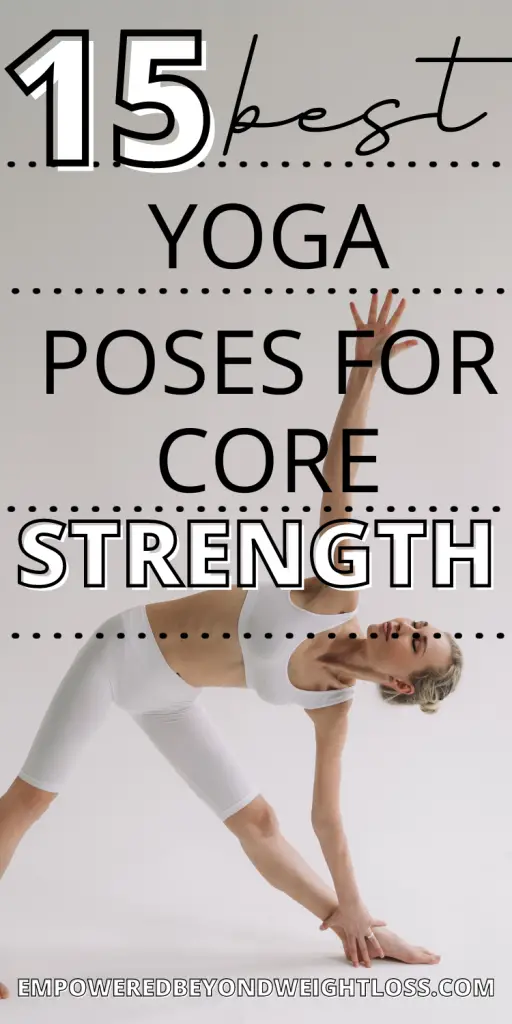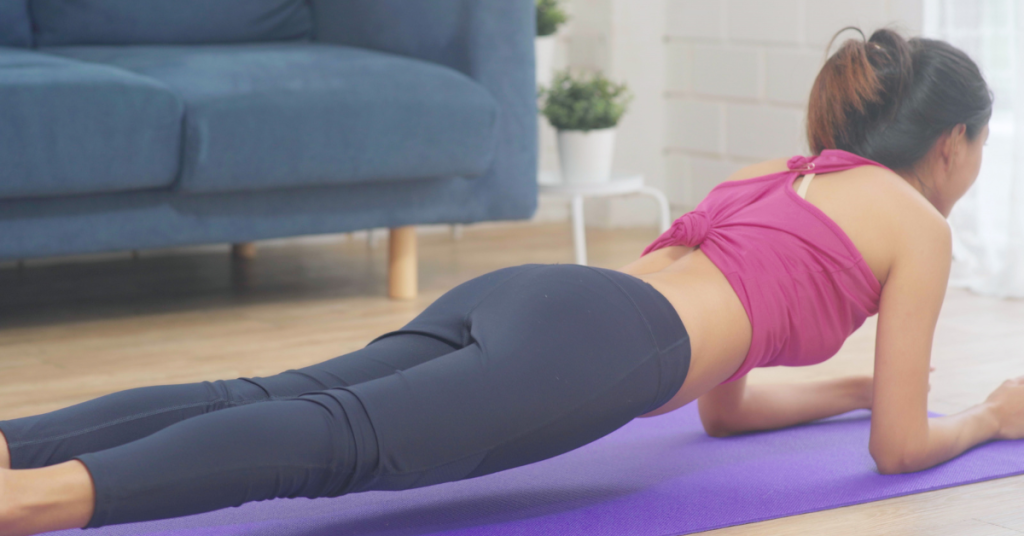I have been writing so much content about the best yoga poses to strengthen your core that I am starting to feel like I am repeating myself. But honestly, most of us need to hear something multiple times before internalizing the information, so I am happy to help and provide you with another yoga core strength routine.
15 Best Yoga Poses to Strengthen Your Core
Let’s start with my favorite yoga poses to strengthen your core. Today’s round-up is similar to what you will find in Best Yoga for a Strong Core: 10 Yoga Poses for Core Strength except I decided not to group all plank poses together. After all, there are some interesting variations that I wanted to showcase.
1. Boat Pose
Boat pose remains one of my all-time favorites. In fact, in today’s routine, we will mostly play around with boat pose and Warrior 3 Pose.
Boat Pose, also known as Navasana in yoga, is a core-strengthening asana that embodies balance and resilience. In this pose, one sits on the yoga mat with legs extended in front and then raises the legs and upper body to form a V shape, resembling a boat sailing on calm waters. The arms are stretched out parallel to the ground, and the core muscles engage to support the body’s balance. Boat Pose targets the abdominal muscles and helps improve posture and balance. It requires physical and mental focus, encouraging practitioners to find stability and calm amidst the challenges of maintaining the pose. This asana symbolizes the harmony between strength and serenity, making it a valuable addition to any yoga practice.

2. Warrior 3
I figured it would be a good idea to place Warrior 3 pose right after boat pose today since you will be experimenting with Warrior 3 in today’s follow-along yoga for core strength workout.
Warrior 3 Pose, also known as Virabhadrasana III in yoga, is a dynamic and empowering asana that embodies strength, balance, and poise. To enter this pose, one begins in the Warrior 1 position with the front leg bent at a 90-degree angle and the back leg extended straight behind, forming a T-shape with the body. The arms are actively extended forward, parallel to the ground. Maintaining a straight line from the heel of the extended leg to the fingertips, Warrior 3 demands intense engagement of the core, leg muscles, and a strong sense of focus. This pose challenges both physical and mental stability, encouraging practitioners to find their inner warrior as they soar like an arrow, symbolizing determination and the pursuit of balance in the face of life’s challenges. Warrior 3 Pose cultivates strength, flexibility, and concentration, making it a valuable addition to any yoga practice.
3. Airplane Pose
Even though I have 500 hours of teacher training, I still had to look up the difference between airplane pose and Warrior 3. I couldn’t remember! And that is because they are pretty similar. Airplane pose is more heart-opening as you lean your heart forward while keeping your arms back, but everything else is like Warrior 3.


4. Side Plank
I said I would showcase some of my favorite planks. Side plank is my top plank exercise, and this Yoga Side Plank Pose (Vasisthasana) Vinyasa Flow was essential to improving my core strength and flexibility. Of course, you don’t need to lift your leg in your side plank, but it is a fun variation to learn when you feel up to it.
Side Plank Pose, also known as Vasisthasana in yoga, is a challenging and strengthening asana that targets the core, oblique muscles, and arm strength. To perform this pose, begin in a plank position, then shift your weight onto one hand and the outer edge of one foot, stacking the feet on top of each other. Lift your hips high, creating a straight line from head to heels, and extend your opposite arm toward the sky or rest it on your hip for balance. Side Plank Pose builds physical strength and improves balance and stability while engaging the entire body. It’s a versatile pose with variations that can be adapted to different skill levels, making it a valuable addition to any yoga or fitness routine.
5. Dolphin Pose
I often talk about how yoga has been life-changing because of its multiple benefits. It increases your strength, your flexibility, and mindfulness all at once! Plus, many yoga poses are pretty much full-body workouts! And Dolphin Pose is a prime example!
Dolphin Pose is a yoga asana that resembles an inverted “V” shape and is a variation of Downward-Facing Dog. To practice this pose, start in a tabletop position with your forearms on the ground and your elbows directly under your shoulders. Then, tuck your toes and lift your hips, bringing your body into the shape of an upside-down “V.” Your head remains off the ground, and you press firmly through your forearms and palms. Dolphin Pose provides a deep stretch to the shoulders, hamstrings, and calves while strengthening the core and improving posture. It’s a preparatory pose for more advanced inversions and offers a sense of calm and rejuvenation as you find stability and length in your spine.

6. Crow Pose
Crow pose is the perfect way to get started with your arm balances. Check out my Step-By-Step Crow Pose Progression for Beginners.
Crow Pose, also known as Bakasana in yoga, is an arm balance that requires strength, balance, and concentration. To perform this pose, squat with your feet close together and your hands on the ground in front of you. Then, bend your elbows and lean forward, placing your knees on the backs of your upper arms. As you shift your weight forward, lift your feet off the ground, balancing on your hands. Crow Pose challenges your core, arm, and wrist strength, requiring a strong engagement of the abdominal muscles to hold the position. It’s a foundational pose for more advanced arm balances and inversions, and it also builds mental focus as you find stability in a precarious position.
7. Forearm Plank
Once in a while, I get someone telling me she struggles with plank pose because it hurts her wrists. Forearm plank is an excellent alternative if that’s you. Furthermore, remember to train your wrist gradually with wrist warm-ups and keep your fingers active.

8. Chaturanga
Chaturanga, often referred to as Chaturanga Dandasana in yoga, is a fundamental and challenging pose often incorporated into vinyasa and power yoga sequences. In Chaturanga, you start in a high plank position with your hands placed directly under your shoulders and your body in a straight line from head to heels. You then lower yourself down with your elbows bent at a 90-degree angle, keeping your body close to the ground. The pose resembles a low push-up, engaging the chest, triceps, and core muscles. Chaturanga is a critical transition pose that helps build upper body strength and prepares you for more advanced yoga poses like upward-facing dog or cobra. It demands control and alignment to protect the shoulders and is an essential element in the flow of many yoga practices.
9. Reversed Plank
The Reverse Plank Pose, also known as Purvottanasana in yoga, is a strength-building asana that targets the back, shoulders, arms, and core muscles. To perform this pose, sit on the floor with your legs extended in front of you and your hands placed behind your hips, fingers pointing toward your feet. Lift your hips and torso off the ground, creating a straight line from your head to your heels. Your chest opens up, and your shoulders are engaged as you press through your palms and lift your pelvis high. Reverse Plank Pose offers a deep stretch to the front of the body while improving posture and strengthening the upper body. It requires balance and flexibility, making it a valuable addition to yoga and fitness routines.

10. Active Cobra
You may find it odd to include backends in yoga poses to strengthen your core, but backends require a lot of core engagement. One of my favorites for activating your core is the active cobra.
Active Cobra, also known as Bhujangasana in yoga, is a backbend pose that strengthens the spine, opens the chest, and engages the upper back and shoulder muscles. To perform this pose, lie face down on the mat with your palms placed beneath your shoulders and your legs extended straight. As you inhale, press through your hands, lifting your chest off the ground while keeping your lower body and pelvis rooted. Active Cobra focuses on using the muscles in your back to lift rather than relying on the strength of your arms. It’s a gentle yet effective backbend that improves posture and flexibility while relieving tension in the lower back.
11. One-Legged Plank
One of my favorite vinyasas is one-legged downdog, one-legged plank, one-legged chaturanga, and one-legged updog. In fact, I decided to include it in today’s workout for you to try.

12. Pendant Pose
The Pendant Pose, also known as Lolasana in yoga, is a challenging arm balance that requires strength and balance. To practice this pose, you start by sitting in a cross-legged position. Then, you place your hands on the ground beside your hips and press down firmly. As you engage your core muscles, you lift your legs off the ground, moving your feet towards your chest. The Pendant Pose resembles a pendant hanging from a chain, as the name suggests. It demands strong arm and core strength to maintain balance while suspended in the air, making it an advanced yoga pose suitable for those with a well-developed practice.
13. L-Sit
The L-Sit Pose is an advanced yoga and calisthenics exercise that challenges core strength and flexibility. To perform this pose, start by sitting on the ground with your legs extended in front of you and your hands placed beside your hips, fingers pointing forward. Press through your palms and engage your core as you lift your body off the ground, keeping your legs straight and parallel to the ground, forming an “L” shape with your body. L-Sit requires a strong core, arms, shoulder strength, and open hamstrings. It’s a powerful exercise for developing abdominal muscles and enhancing overall body control, making it a popular choice in advanced yoga and bodyweight training routines.
14. Turbo Plank
Turbo plank is an excellent hip flexor and core strengthening plank variation. Bring one knee to your chest from plank pose as seen in Crazy Effective Hip Flexor Strengthening Exercises.
15. Chair Pose
Chair pose is another not-so-obvious yoga pose to strengthen your core (which I included in today’s routine).
Chair Pose, or Utkatasana in yoga, is excellent for engaging the core muscles. Here’s how it works:
- Squatting Position: In Chair Pose, you start by standing tall with your feet together. As you bend your knees and lower your hips, you must engage your core muscles to maintain stability and balance.
- Alignment: Your torso naturally leans slightly forward in this pose, and your arms are raised above your head. To maintain this alignment and prevent yourself from tipping forward, you must engage your core muscles, particularly the lower abdominal muscles.
- Spinal Extension: Chair Pose encourages a slight arch in the lower back. To maintain this arch and prevent your back from rounding or collapsing, your core muscles, including the rectus abdominis and transverse abdominis, are actively engaged.
- Balancing Act: Balancing on your tiptoes or the balls of your feet in this pose requires core strength. It’s about lifting your upper body and stabilizing your entire body as you hold the position.
Overall, Chair Pose demands a strong and active core engagement to maintain proper form and alignment, making it an effective exercise for strengthening the abdominal muscles and improving overall stability and balance.
This week’s workout includes a combination of chair, airplane, warrior 3, boat pose and more:
In Summary
Most yoga poses engage your whole body, hence your core. That’s why I love yoga so much! It is a very holistic practice. You are not isolating body parts. Instead, you are learning to integrate them to experience joyful movement as you feel how everything works together and how feelings evolve.
Want more? Don’t forget to check out my 5-Day Yoga Habit Challenge.





